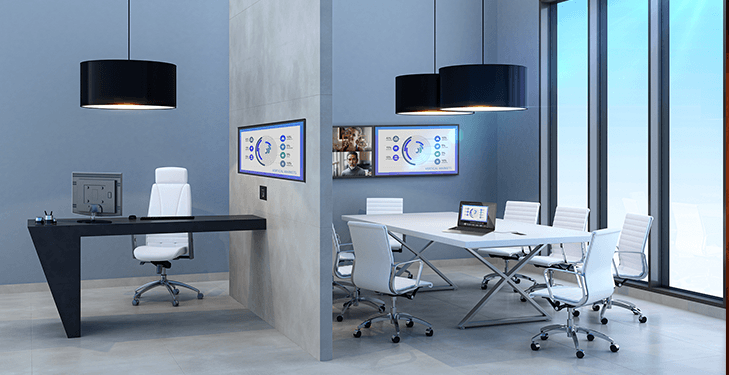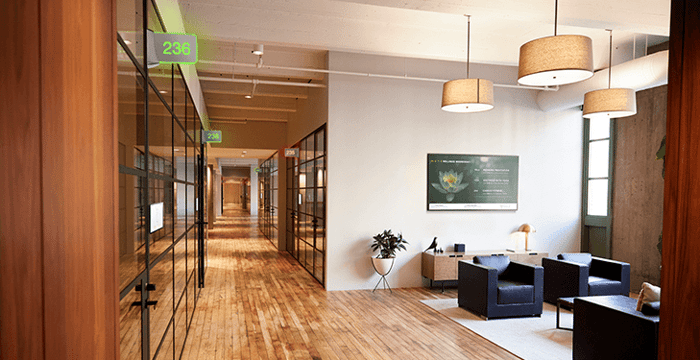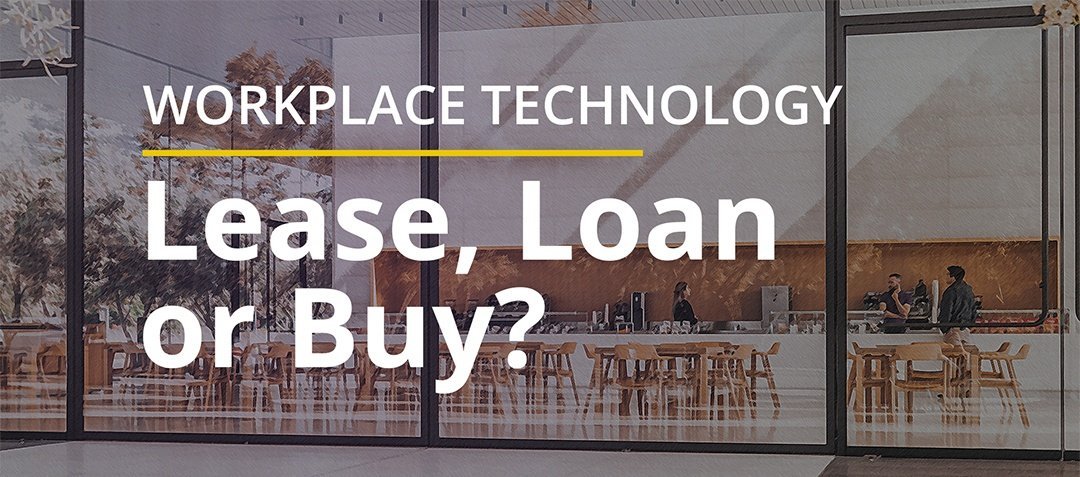Investing in technology is investing in your organization. Modern systems can improve morale, increase productivity, and boost revenue. However, buying such high-ticket items every couple of years isn’t always feasible -or necessary- for most businesses. So, should you lease, loan, or buy your workplace technology?
Lease, Loan, or Buy
Be it hospitality, retail, corporate office space, or manufacturing, there are pros and cons to each purchasing option. To determine the right route for your business, you should start by asking yourself the following questions and reviewing the pros and cons.

What’s the lifetime of the technology?
Technology is rapidly evolving, what’s breaking-news one day tends to be obsolete in just a few years. This creates a costly and inefficient technology environment in many organizations. Leasing is an excellent option for companies that want to ensure that they always have cutting-edge solutions. However, some technology is okay to have around for several years; in this case, buying outright will make more sense.
Does your organization have the cash flow to support buying outright?
Purchasing technology upfront can be an intimidatingly enormous cost, and your organization needs to be in a very good spot to undergo such an expenditure. However, if it’s a smaller purchase and there is room in the budget, this option may save you money in the long run.
Leasing, on the other hand, allows you to get access to technology with a minimal upfront investment and ongoing fixed monthly payments. It also minimizes unforeseen financial surprises if anything should happen to the technology since support services are typically factored into the agreement.
Workplace Technology: Lease
Pros
-
Up-to-date technology
-
Predictable monthly line item (operating expense)
-
Frees up funds
-
Lower barrier to entry for expensive equipment that can provide additional revenue
-
Bundle with a service level agreement for easy maintenanceLeasing firm assumes risk for equipment
-
Accelerated depreciation for tax advantages
cons
-
Wind up paying a bit more
-
Locked in even if you stop using the technology
-
Slightly more complex buying process
-
Not everyone is eligible
Workplace Technology: Loan
Pros
-
More control over your IT assets
-
Interest can be written off
-
Control maintenance standards
cons
-
Assume risk for equipment
-
Capital expense
-
Down payment ties up funds
-
Must deal with obsolete technology
-
High/Variable interest rates increase total cost
Workplace Technology: Buy
Pros
-
More control over your IT assets
-
Faster purchasing process
-
Control maintenance standards
cons
-
Assume risk for equipment
-
Capital expense
-
Tie up funds
-
Must deal with obsolete technology
-
Assets must appear with a corresponding liability on balance sheet
Leasing Workplace Technology
Leasing your workplace technology opens up doors to a whole new realm of opportunity and benefits, but the decision should not be made lightly. Below are some questions to consider before signing off on any leasing agreement.
Will the lease be CapEx or OpEx?
It’s crucial to understand the type of lease you sign as the outcomes are very different. With a capital lease, the technology is considered a depreciable asset on your balance sheet. An operating lease is different in that the leasing company retains ownership for tax purposes, and your business claims it as a monthly operating expense. Operating leases are usually short-term, lasting three years or less, and they don’t tie up funds. There may be additional tax incentives to leasing, we recommend speaking with a tax professional before making a decision.
Can you make adjustments to the lease?
Is it possible to add to the lease if things change? Perhaps you hired several new employees, or decide to upgrade a conference room, will fees be applied if you want to adjust your lease? Understand how “flexible” the contract is in the long run and make sure the terms won’t change if you need to add to it.
How long is the lease?
The longer you lease, the lower your monthly payments. If cash flow is tight, then longer leasing agreements can give you access to higher-end systems. Just make sure the lease term doesn’t extend beyond the necessary lifetime of the technology. After all, the goal of leasing is to mitigate the risk of obsolescence.
What happens at the end of the lease?
Is there a buyout option? If so, is it an FMV or $1 buyout option? A fair-market value (FMV) buyout, means you can purchase the equipment at the lease’s end for whatever it’s worth, which could be thousands of dollars. A $1 buyout option means the technology can be bought for a dollar when the lease comes to an end. Although the $1 buyout option seems like the clear winner, the monthly payments are generally higher with these terms. So if you know that you’ll want a system upgrade at the end of your lease, the FMV option could be the way to go. You may also have the opportunity to update your systems and continue with your monthly payments, keeping your systems up-to-date without feeling the pain of a large technology purchase.

The right purchasing decision depends on your organization’s current situation and technology requirements. Each option -leasing, loaning, or buying- tends to have a “best-fit” persona. See which one you fall into.
Leasing can be a cost-effective option for:
- Enterprises with limited capital
- Those who want to keep their funds open and available
- Companies that need to upgrade their technology every couple of years
- Growing companies that need technology to succeed but can’t quite afford it through traditional payment options
Loans are a good fit if:
- You can get a low, fixed interest rate
- Your budget can cover the upfront deposit
- Technology that doesn’t need to be upgraded regularly (i.e., structured cabling)
Buying makes sense for:
- Established firms that have room in their budget to purchase outright
- Smaller technology investments
- Technology that doesn’t need to be upgraded regularly (i.e., structured cabling)
This is a lot of information to digest and consider, and it all means one thing: there is no one size fits all solution.
For most businesses, leasing technology is a great option because it preserves cash flow and keeps your systems up to date. If your funds aren’t tied up with large expenditures, you can use that working capital to invest in your business (advertising, marketing, hiring initiatives, etc.) and protect yourself from unexpected liabilities. Leasing also simplifies budgeting and forecasting which can strengthen your financial position.
In today’s world, updated and modern technology empowers your organization to operate effectively. Productive and efficient workspaces create productive and efficient employees. Which means the best benefit of all: increased revenue.
Click below to download our Workplace Technology Lease, Loan vs. Buy comparison chart. This can be used as a resource when you’re weighing the options with your team.
Learn more about ASD's Technology-as-a-Service program.


Leave a Comment